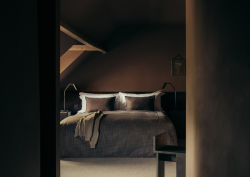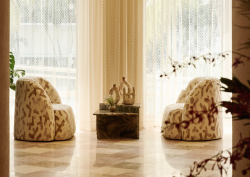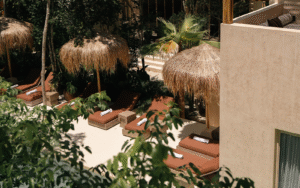After setting his watch to ‘Gili time’, and being persuaded to say goodbye to shoes for the duration of his trip, Editor Hamish Kilburn experiences what is like to feel shipwrecked on Gili Lankanfushi, one of the most raved-about island hotels in the Maldives – and for good reason…
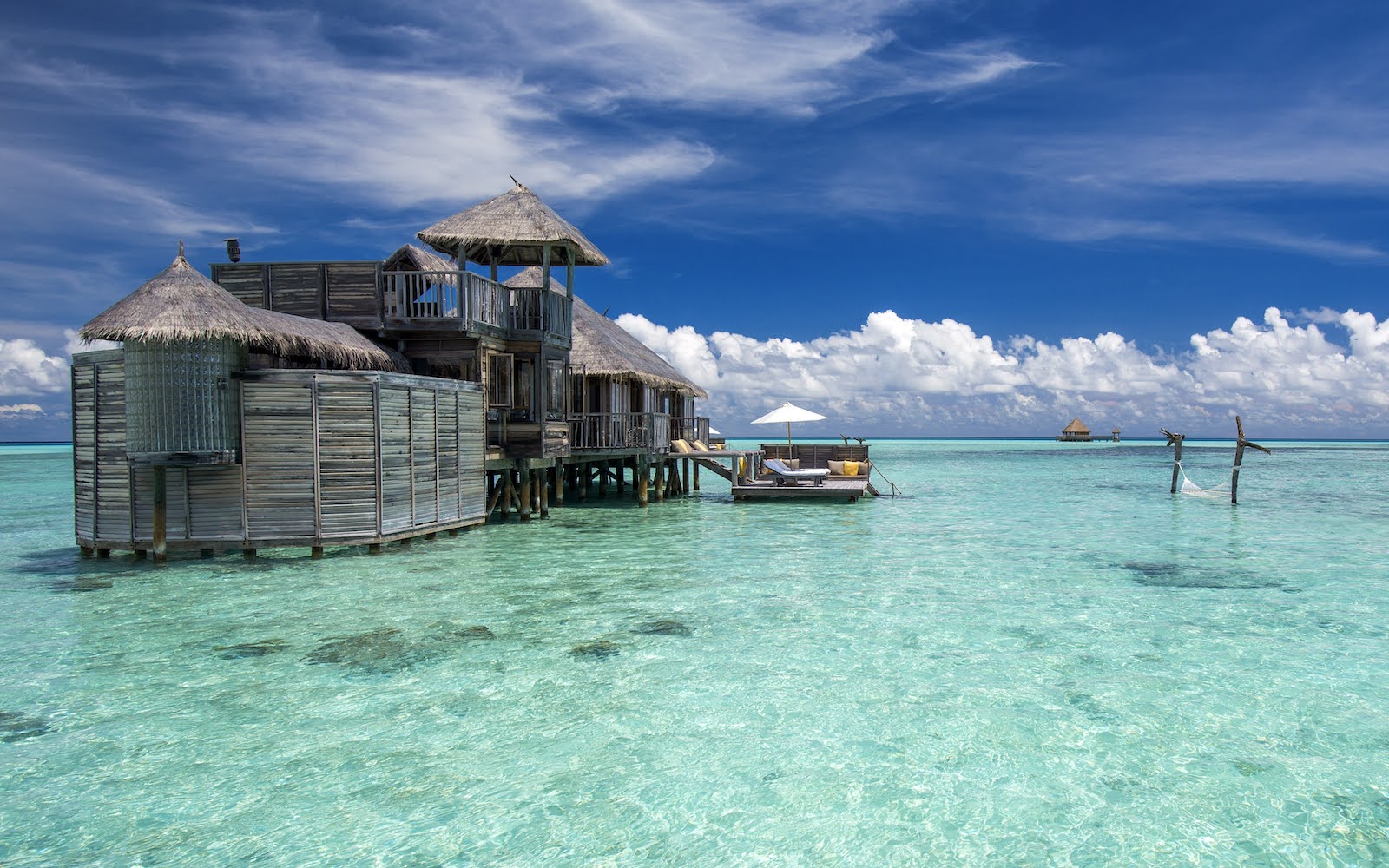
The closest I have ever come to feeling shipwrecked happened recently when I checked in to Gili Lankanfushi, in the Maldives just 20 minutes by boat from Malé. The luxury island hotel effortlessly balances style, design and innovative eco initiatives in a place, and it makes its own rules. Adjust your watches to ‘Gili time’ – yes, it even has its very own timezone – and even don’t bother packing shoes.
Often in hotels, it is the in-between moments – what guests capture on the journey between one experience to another – that count most. In Gili Lankanfushi, for those staying in the resort’s most secluded villas, this requires a water taxi to whisk them away from the shore and on to a mini adventure of their own, where they’ll pass shoals of reef sharks and resting rays, to arrive just five minutes after at the front door of one of the seven Crusoe Residences, named after the famous character, Robinson Crusoe. Feeling deserted in paradise is the overarching yet loose theme of the resort; to embrace shipwreck-chic. These particular villas promise complete privacy, and each frame endless views that stretch out and across towards the Indian Ocean.
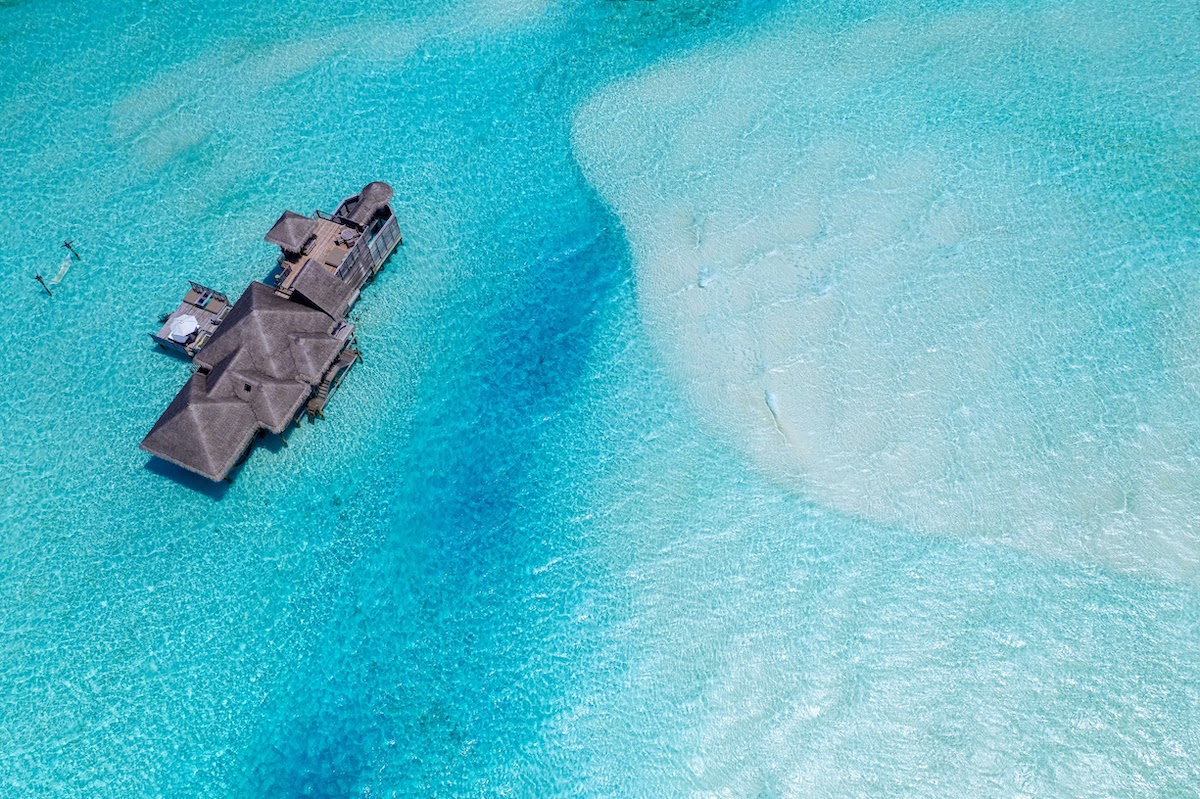
Image caption: The Crusoe Residences are only accessibly by boat, evoking an unmatched shipwrecked in luxury travel experience. | Image credit: Gili Lankanfushi
The Crusoe Residences are stunning, but, in truth, all 45 villas on the island – all of which are overwater and most are accessible by foot or bamboo bike – are similar in style and offering. Aside from the Private Reserve (more about that record-breaking beast later), all accommodation styles are also similar in size – leaving only guests’ personal preferences to decide between them. Under thatched roofs, each timelessly designed villa shelters the resort’s signature open- or semi-open-air bathroom concept, where you can hear small waves crashing underfoot, and which comes complete with a large freestanding bath, twin vanity sinks and a private outdoor shower.
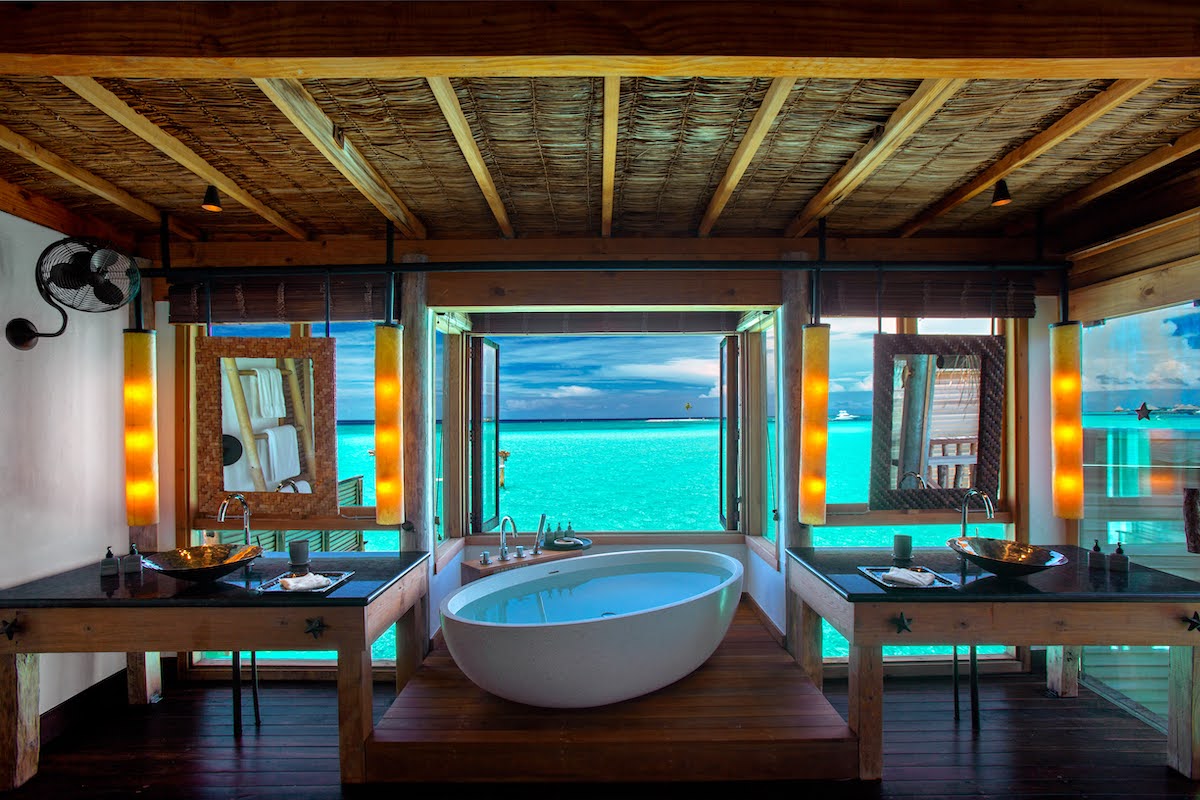
Image caption: Due to all of the villas in the resort being overwater, guests can hear the sound of the ocean underneath their bathrooms. | Image credit: Gili Lankanfushi
Intelligent as well as beautiful, the two-floored villas are designed to catch the natural ocean breeze, with counter-current heat exchange systems and large roof overhangs to increase shading while minimising the need for air conditioning.
The bedrooms have been architecturally designed to feel separate from the rest of the structure, accessed by guests walking outside the lounge area and into a separate enclave. These spaces are quite literally tranquil spaces that sit on stilts. Complete with large beds made from recycled teak wood, the rooms are large, inviting and calming. There is a noticeable lack of conventional art on the walls. Instead, natural materials, that I can only guess were off-cuts used from when the furniture was being carved, are hung masterfully on the walls to add texture.
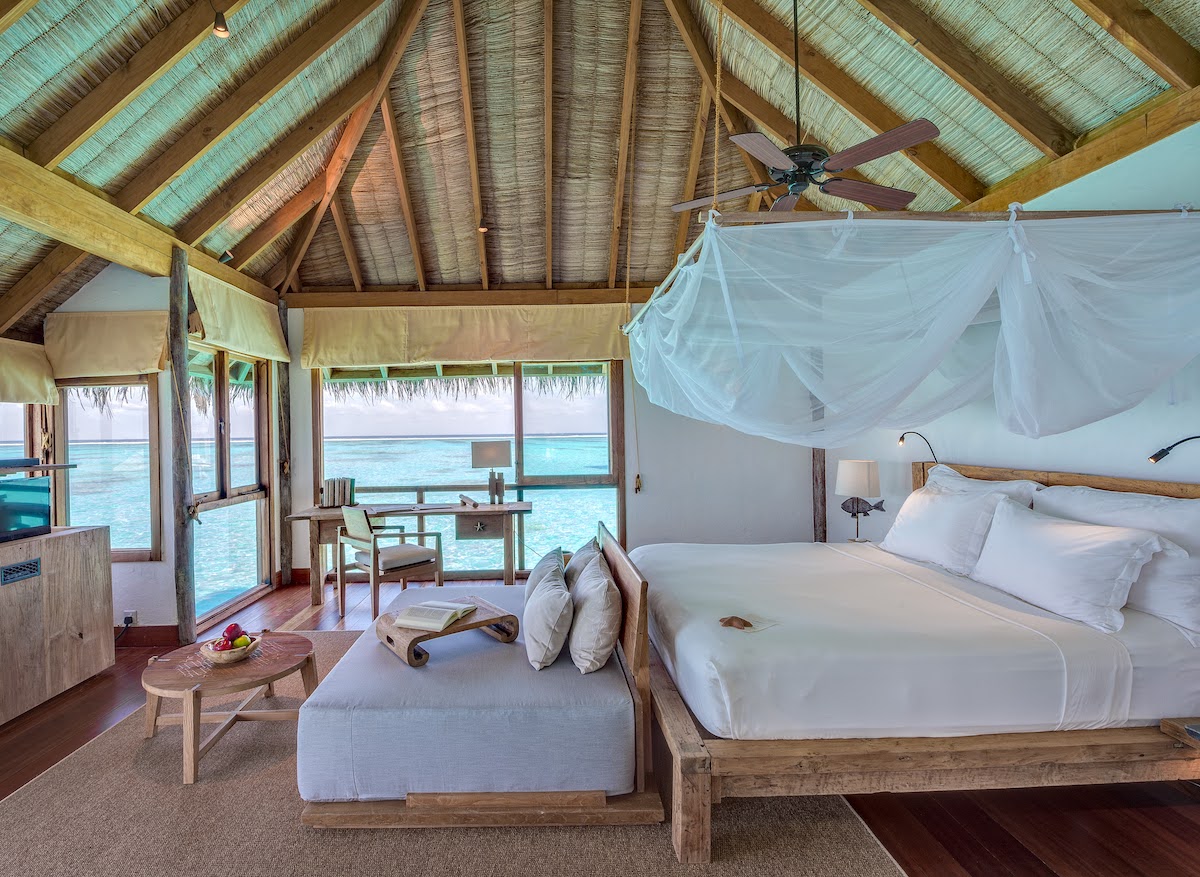
Image caption: Tranquil, light and airy. The bedrooms a peaceful nooks that frame spectacular views over the Indian Ocean. | Image credit: Gili Lankanfushi
But the real art is nature itself, either captured through the glass windows or, in places, through a dramatic glass floor, to see all colours of marine life. When looking closer at each element within the villas, you will start to see the work – and personality – of the interior designer who, after a year-long renovation between 2019 – 2020, helped the resort evolve with a more subtle interior scheme that compliments the architecture throughout.
His name is Maverick, who, believe it or not, likes to go under the radar (with no website or business address anywhere to be found). His unmatched skillset in sourcing organic materials in this region attracted the resort to ask him, in person, to refresh the interiors after he made a trip to the island in April 2018, which is when he was first taken in by Gili’s relaxed nature. “When I first set foot on Gili Lankanfushi, I just felt a kind of magic of the place that I couldn’t at first put my finger on,” he told me. “This magic, it turns out, is not the design. Instead, it is how humble the resort is. When I started working with the team, my core aim was to ensure this essence was not lost.”
Soon after accepting the brief to renovate, which was at the time, just part of the island’s accommodations, disaster struck. On the eve of January 2, 2019, a fire broke out – every island resort’s worst nightmare. The locals told me that it started 300 metres from the island, on the Private Reserve, but due to the wind speed and direction, the fire spread quickly to the eastern promenade, and later destroyed seven villas in total and the restaurant on the south of the island. Miraculously, no one was injured, but the event remains etched in the minds of everyone who works there. Despite it being undoubtedly devastating, I also got the sense that this event was when the team’s resilience and sense of community became fiercer.
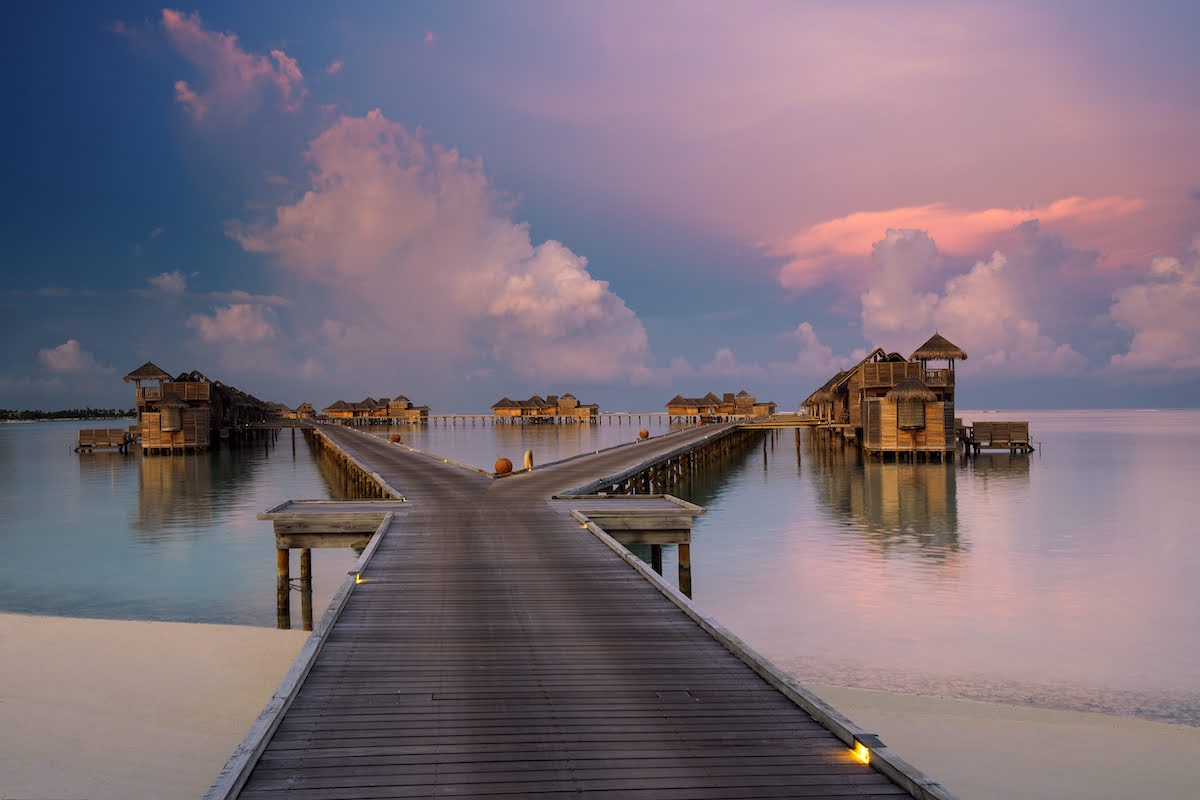
Image caption: In 2019, a fire destroyed seven overwater villas, which were rebuilt using reclaimed wood in order to maintain the rustic-chic design scheme. | Image credit: Gili Lankanfushi
Following this event, Maverick’s role extended to allow the resort to, yes, rise from the ashes. His method to reimagine Gili Lankanfushi, post-fire, was genius, as well as equally sustainable. “I sourced the wood from abandoned homes and train stations in Indonesia,” he explained. “This was not only an ethical decision. It was the only way to achieve the rustic luxury look and feel that the resort is loved for, and for there to be no ‘time stamp’ between the new villas and the existing ones.” With zero excuses or tolerance for cutting corners, every aspect of the resort has been designed with sustainability in mind. All buildings, on the island, are constructed using reclaimed plantation teak, palm wood, bamboo and palm fronds, whilst the overwater villas and jetties are supported with recycled telegraph poles.
In addition to saving the resort’s aesthetics and charm, the true narrative is in the detail. As I spoke to Maverick from my villa, he asked me to look closer at the desk lamp. “Can you see?” he asked with a smile beaming across his entire face. “[The lamp] is a carving of a couple arm-in-arm, looking out towards the ocean.” Once you notice one characterful artefact, others appear. The lampshades on the walls, for example, reference a turtle’s back and the soft furnishings – the cushions specifically – have a design scheme that reflects living coral – I was told that each villa has a slightly different colour scheme. Meanwhile, the wooden coffee tables are carved with stars – so too are door handles on the draws and cabinets – which sensitively reflect the undisturbed night sky in the Maldives – looking up at night is a further reminder of just how removed guests are from modern life.
“The table is made from a tree trunk that was washed up here after the 2004 Tsunami.” – Maverick.
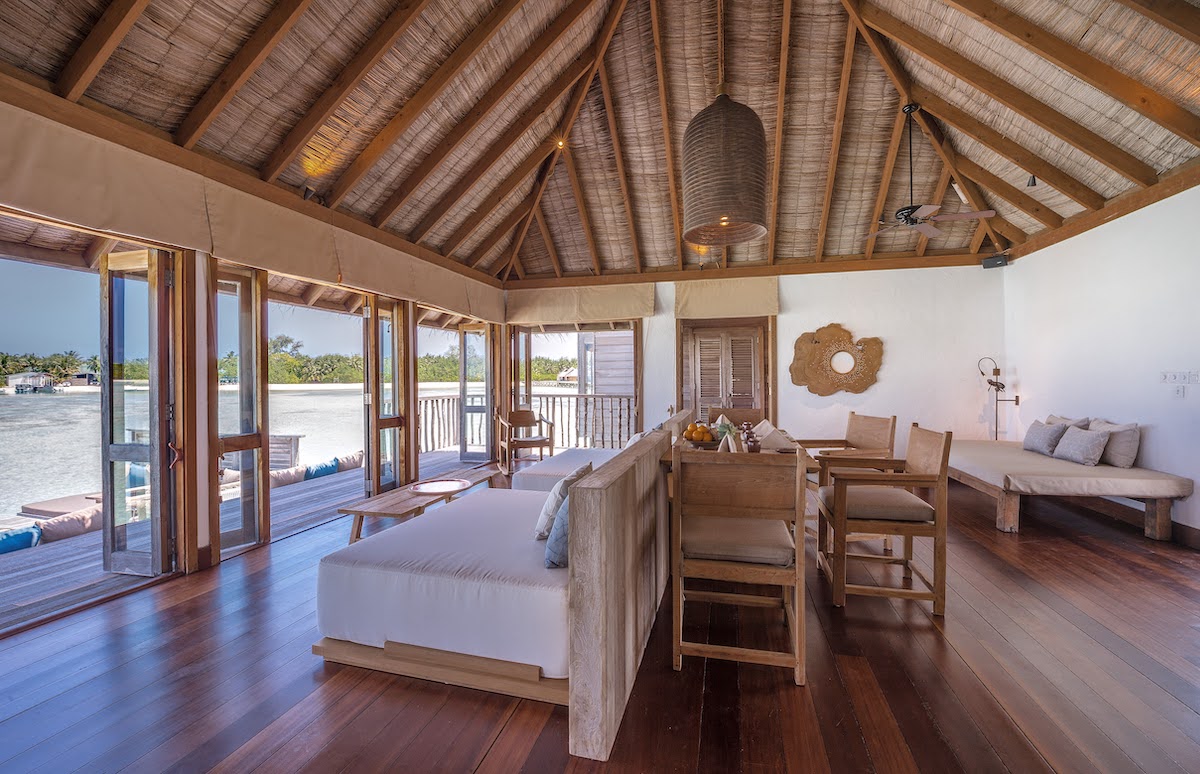
Image caption: Maverick has used natural material as art in pockets of the villas. | Image credit: Gili Lankanfushi
It was hard to comprehend, when walking around during the day on an island that feels entirely abandoned, that the resort was at 80 per cent occupancy. The clever layout of villas means that everyone is entitled to their own space, and private entrances into the lagoon. During the day, therefore, guests tend to keep to their own adventures. By night, though, the island comes alive with guests eating at one of the two restaurants to enjoy local, fresh ingredients from the resort’s garden or from the ocean. The menus, in each restaurant, have been perfectly curated by the head chef, Chef Hari, who after 15 years has become what I would describe as a ‘Gili island treasure’ thanks to his innovative approach to cooking and his relationship with his ingredients – it’s like he sees each plate as a blank canvas.
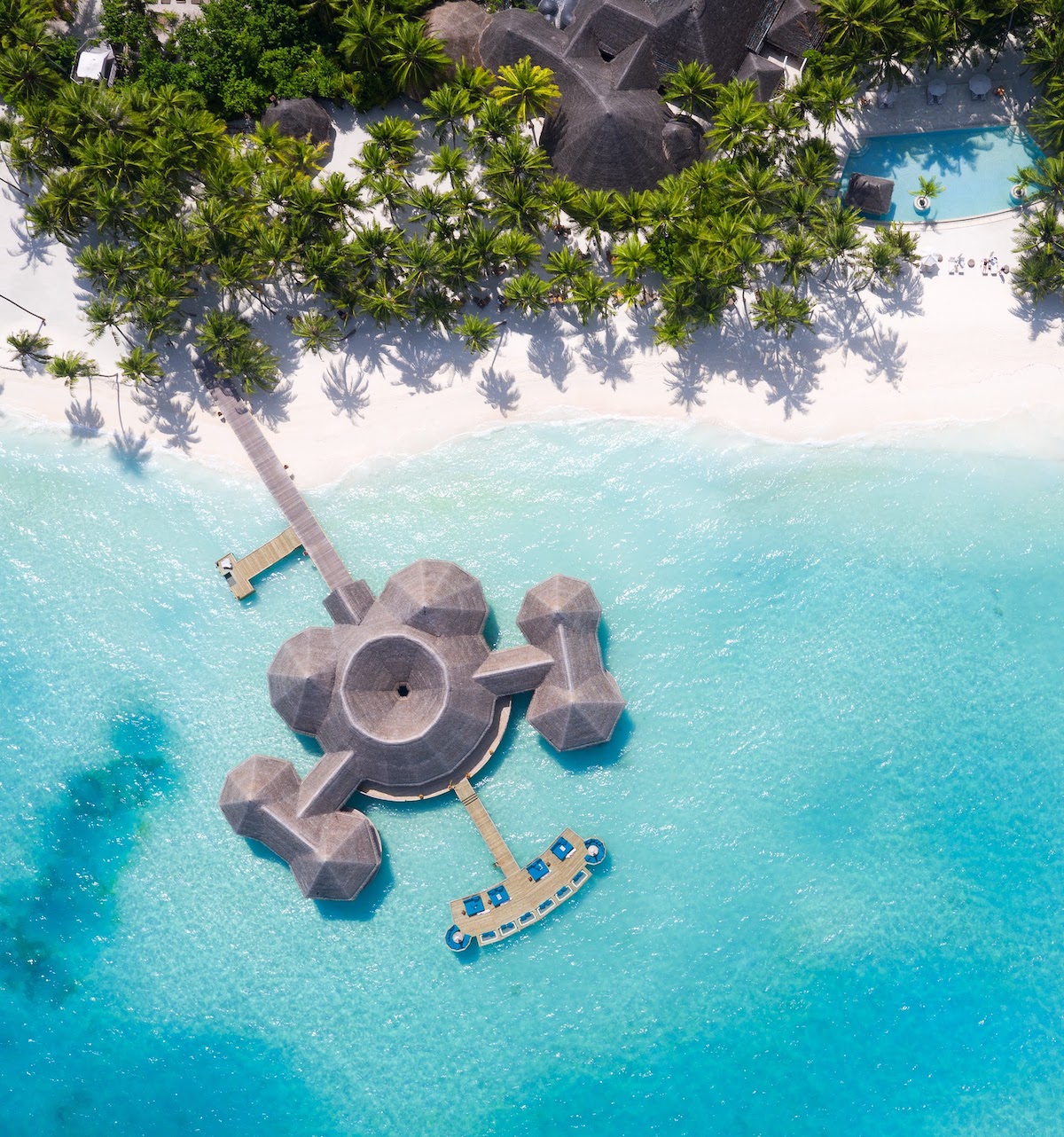
Image caption: The overwater bar and restaurant is where guests gather in the evening to capture the sunset. | Image credit: Gili Lankanfushi
Tucked away, below the surface, is the wine cellar. Beyond sheltering expensive magnums of Champagne and other extravagant wines that, quite frankly, made me feel nauseous, there is nothing more valuable in the cellar, from a designer’s perspective at least, than the table itself. That is because it, like many other details in the hotel, is attached to a fascinating and heart-warming story of restoration and regeneration. “The table is made from a tree trunk that was washed up here after the 2004 Tsunami,” Maverick explained. “Giving materials new chapters is what Gili Lankanfushi is all about.”
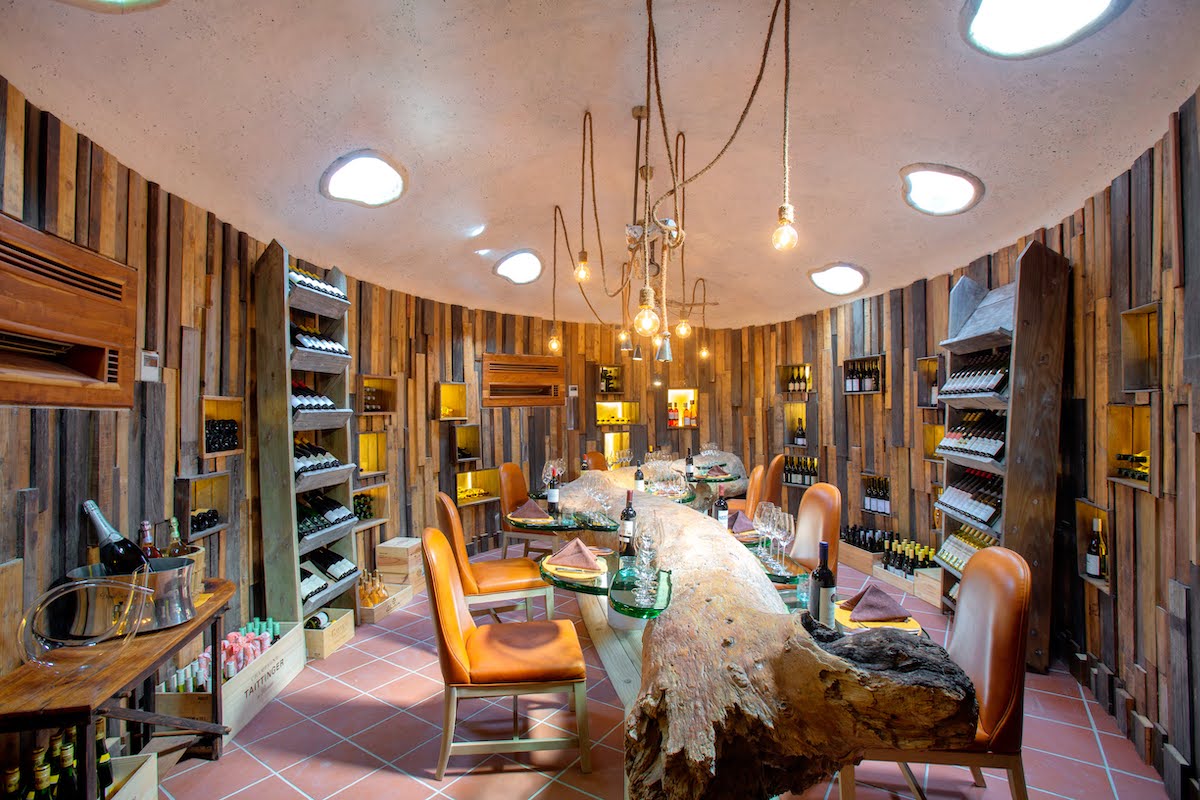
Image caption: A table in the wine cellar made from a tree trunk that was washed up on Gili Lankanfushi after the 2004 tsunami. | Image credit: Gili Lankanfushi
The winding nature of the trunk is, alone, awkward. However, with it being the statement of the space, with small glass tables on either side for wine tasting events, it’s as if the room works around that element and not the other way around. The walls, meanwhile, are cladded with other miss-matched pieces of reclaimed wood that, too, washed up on the shores after that natural disaster. It feels like the hotel is answering to these natural events with a message of hope for the future; design’s greatest weapon: the power of reincarnation.
On the other side of Gili Lankanfushi, facing South, Meera Spa is designed to be an ‘island’ of its own, if you like, which is accessible via a long pontoon that channels one’s body, mind and soul into a calm, overwater space. To add a sense of wellness, and to really help capture a sense of place for guests unwinding and healing, the treatment rooms are complete with glass floors under massage beds so guests can watch the marine life during their holistic treatments.
You may have by now realised that Gili Lankanfushi has a purposeful relationship with nature, in both design and hospitality – its sustainability credentials alone are a reflection of that. Having achieved silver certification in 2017 from EarthCheck, it is now working towards gold certification. From every corner, it is clear that the hotel does everything it can – including planting plots of seagrass, creating man-made coral lines and launching its very own marine research facility – to preserve and protect the fragile marine ecosystem, asking guests to leave only footprints in the sand behind them.
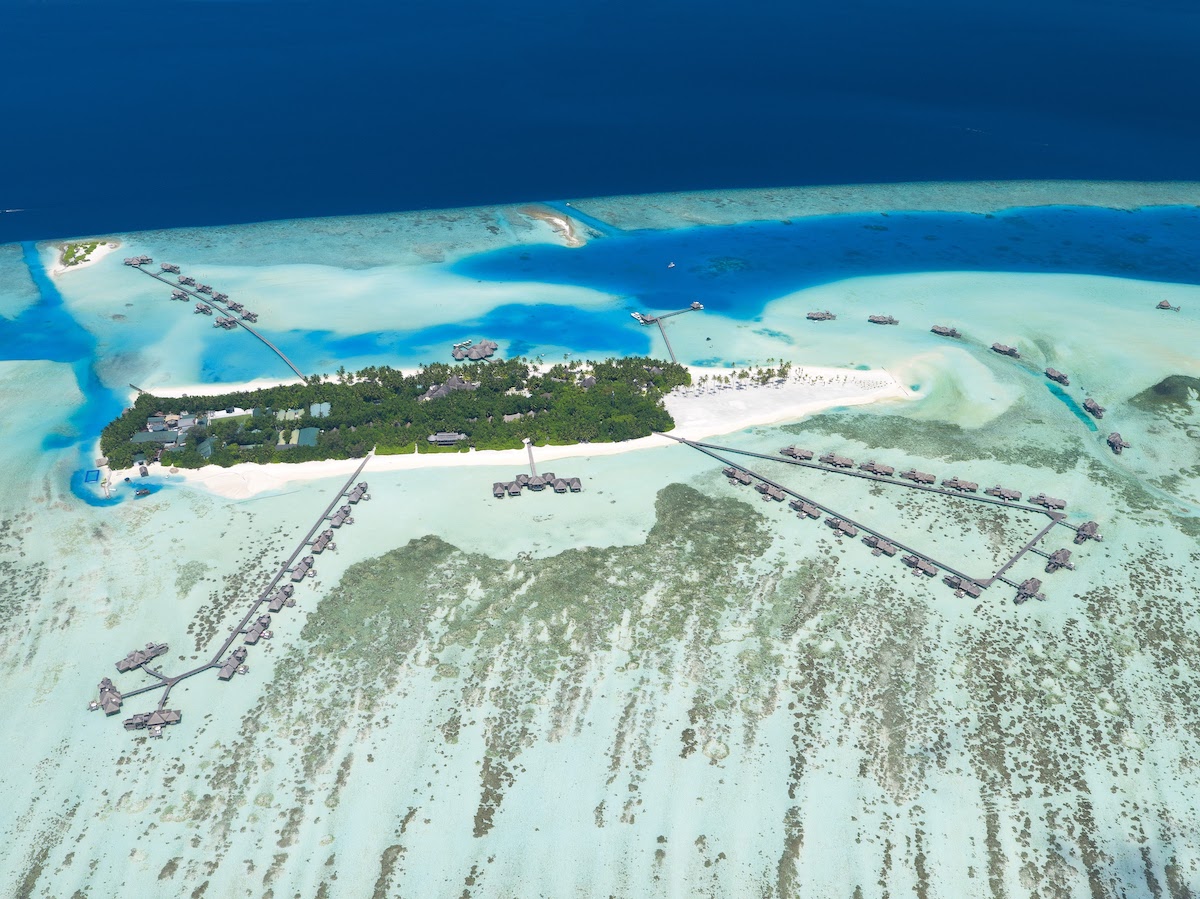
Image caption: From the air, it is clear to see how small the physical island is compared to its vast pontoons that branch off its white sandy beaches. | Image credit: Gili Lankanfushi
Crucially, waste management is the biggest talking point on any island in the Maldives, with all plastic famously being sent to one island to be burned due to the lack of resources – this is the reality of over tourism in the Maldives. But Gili Lankanfushi has a solution. It has a strict ‘no plastic’ policy, but it still encounters a lot of floating plastic ‘carried on the currents from other islands’. In 2017, it invested in its own plastic recycling scheme in partnership with Parely Maldives to intercept single-use plastics and prevent them from entering the ocean. The island also has a fully functioning Eco Centre that recycles glass, plastic, aluminium and food waste. Glass is ground up and donated as aggregate, aluminium is crushed to prove scrap metal, plastic is stored and donated and food waste is processed into compost. All this while maintaining the speed and efficiency of a luxury hotel.
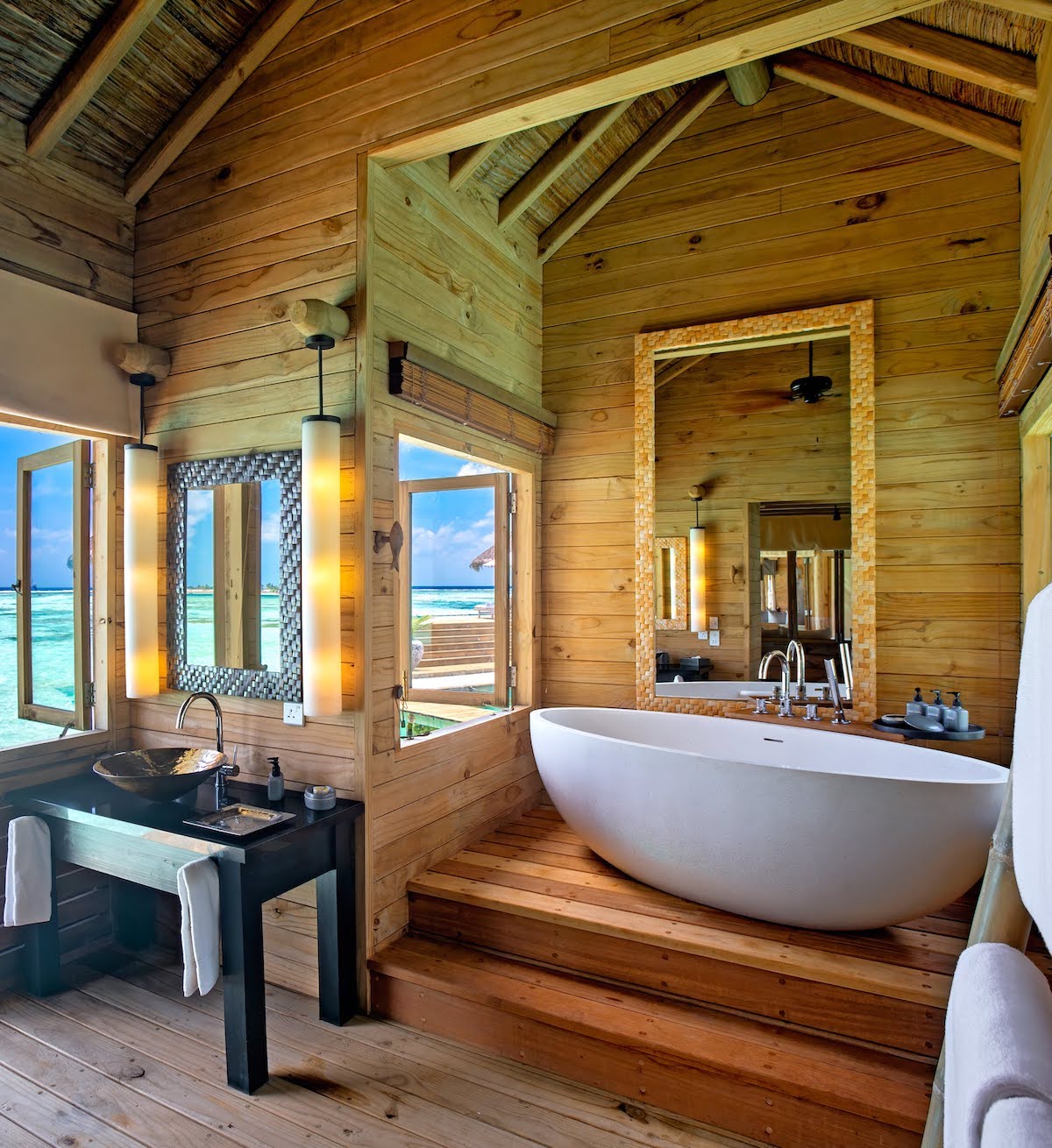
Image credit: Gili Lankanfushi
With everything that the resort has to offer, and all that it has achieved in terms of reputation among high-earning travellers, it is somewhat surprising that I have come this far without highlighting, in detail, what Gili Lankanfishi is in fact best known for. The Private Reserve, located within the lagoon but surrounded by nothing but clear water, grabs the headlines for it being the world’s largest standalone overwater – it’s like walking through a hotel within a hotel. But I have to admit that, as well as it being the largest, it is also the best. In true Gili style, it hasn’t been over-designed, and it shelters the same design narrative as all the other villas.
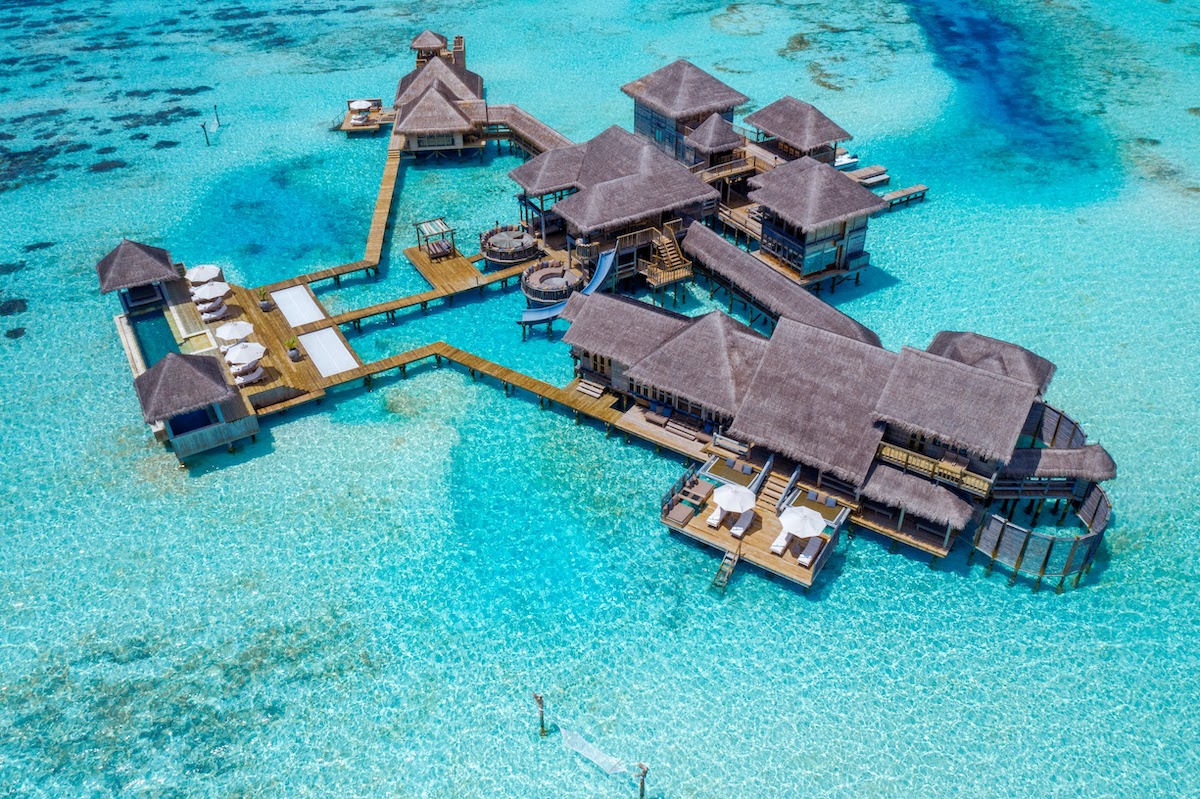
Image caption: Gili Lankanfushi is home to the world’s largest standalone overwater villa. | Image credit: Gili Lankanfushi
The ‘world’s most famous residence’ is set across 1,700 square metres, comprising of five vast buildings linked by open-air walkways and that slide into the ocean, which is spectacular. It also shelters – and I use that term lightly – an open-air cinema, its own spa, a 21-metre pool and a fully equipped kitchen. The truth, though, is that the island has so much more to it than its largest residence, and it’s almost bizarre that, given the resort’s eco mindset together with its ambition for the place to feel unpretentious at all times, that this would be where a record-breaking villa would sit. But I guess, with a sensitive approach, opposites really can attract in paradise.

Image credit: Gili Lankanfushi
Of all the barefoot luxury experiences at Gili Lankanfushi, saying goodbye is, by far, the hardest. Watching the waving arms of the people who made every travel moment count shrink into the distance is yet another reminder that luxury moments don’t need to last forever in order to be impactful. My time at Gili Lankanfushi has inspired me to explore the hotels that are breaking boundaries, stripping back the concept of luxury and not just surfing the wave of sustainability to operate in a more socially and environmentally aware arena.
Main image credit: Gili Lankanfushi






